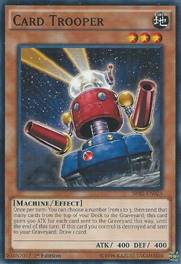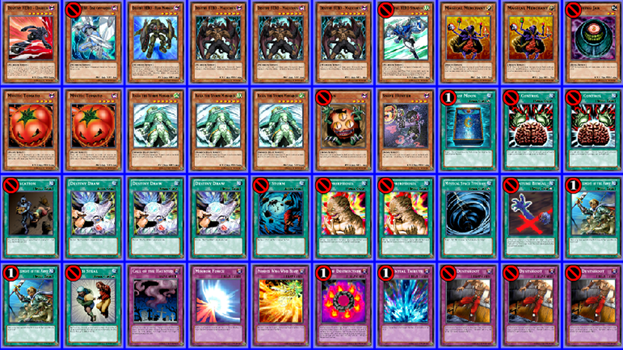|
|
|||||
| Pojo's Yu-Gi-Oh! news, tips, strategies and more! | |||||
|
|
|||||
 |
|||||
|
Card Game Featured Writers Releases + Spoilers Anime Video Games Other
Magic
This Space |
Baneful's Column [Trooper Format] Pt. III
This card is really the heart and soul of the format. It’s a source of card advantage, potential for OTK’s, Giant Rat support, Machine support and, of course, milling the deck allows cards like DHERO’s, Green Baboon, Zombies and you-name-it to be accessed from the graveyard.
Use your Card Troopers wisely. Using it as a 1900 ATK Sangan-like beater-floater is viable but not always the best way to use it. Sometimes you may want to save your Trooper until your draw your Machine Duplication. Or, you may want to use it when you truly need to mill through your deck for a combo. Or, you may want to use it as a way to put pressure on opponents which you suspect are setting a Mirror Force or Torrential Tribute. The cardinal sin of the format is leaving your Trooper exposed face-up. Unless you happen to have a Book of Moon, you are at risk of the opponent using Brain Control on your Card Trooper, and then using Machine Duplication to summon 2 more Card Trooper from their deck. If they also have Limiter Removal or any monster that can deal damage. You will need to use your own discretion on when to take this risk.
Commitment
The fundamental crux of this format is how many resources the player commits to the board. Commit too few resources, and you’re asking to be OTK’ed. Commit too many resources, and the opponent will punish your play with a power play of their own; then you’ll realize you lack the cards in hand to handle these threats because you already used them on your board.
In this format, you want to goad your opponent into being forced to use one of their power cards sooner than they would like to. Goad them into using a Card Trooper prematurely or summoning a Monarch just to clear a small-time threat. One example is Dekoichi. It’s a net loss for any player to use removal on it once its flipped, so the opponent has to summon a monster to get rid of it. Decks with a lot of effect-based removal and very few monsters over 1400 ATK may need to overextend to handle this threat.
Hindsight Observations
There are a few things about this format that I realize in retrospect. First, dedicated Monarch decks were somewhat overrated for their time. The introduction of the HERO and Trooper engine changed the game in ways many players used to playing Monarchs in 2006 didn’t comprehend. The problem with Monarchs is that the deck gets inconsistent hands from relying on both a large amount of tributes and having a lot of tribute fodder. Pure Monarchs are easily disrupted by Trap Dustshoot and aren’t very flexible; all they can do is tribute monsters for bigger monsters and beat things down. They lack the speed of the DHERO engine, the ability to play defensively when necessary and the ability to go in for a game-finishing OTK.
Second, Snipe Hunter was overrated by many. I understand that decks with discard fodder (like DHERO Malicious) and Mystic Tomato can benefit from using it. But a lot of people (in all sorts of decks) were just using 2-3 copies because they felt like it was a staple, when it was prone to bad luck and is basically just a 1500 vanilla beater if the discard proves to not be advantageous.
Third, Diamond Dude Turbo had far more potential than people knew at the time. With modern knowledge, it would have been tier 1 back then. Some players were running bad cards and others didn’t understand the full extent of how to use the deck’s combos to effectively interact against the opponent’s deck. I’ll contend that skillful players may want to face against DDT to test their knowledge of the format’s in’s and out’s, while the majority of players would probably be happier if they didn’t face a deck that blazes through half of its deck in an entire turn and relies on an OTK. I will leave it up to you on whether or not to have a gentleman’s agreement to not use DDT.
T-Hero vs. Perfect Circle
I may not have made this perfectly clear in the prior articles, but Destiny Hero Monarchs are not one uniform deck type. There a different ways to use the same cards. While only a few cards are different, it affects the whole playstyle. Perfect Circle uses the DHERO engine as fodder for summoning Monarchs to control the field. T-Hero (named after Theraseek Ponsoombat – great name) uses no Monarchs and instead uses 3 Card Troopers, Limiter Removal, Jinzo and Dark Magician of Chaos. DMoC particularly, apart from recycling a spell card for free, is a LV8 Metamorphosis target for Cyber Twin Dragon, which can put 5600 damage on the board! Perfect Circle is more focused on controlling the field and staying ahead in resources whereas T-Hero is focused on setting the board up for an explosive play.
J-Hero
There was one deck that I forgot to add to the previous article. J-Hero, named after Jazz (writer for the Format Library blog) and Jake, who have tested this format through over a few hundred practice duels. I also want to help Jake for giving me a lot of useful information for this article. This J-Hero build is a beautiful deck list with a fair bit of synergy.
It forgoes Card Troopers for Magical Merchants in the main deck. Why? Magical Merchant discriminates between the monsters you want in your graveyard versus the Spells/Traps that you want in hand, unlike Card Trooper which is more of game of chance. Double Metamorphosis can turn floaters like Malicious into LV6 Fusions. The goal of this deck is to get the opponent to commit resources on the board to kill this desk’s floaters, and then to punish the opponent with an aggressive play once they’ve over committed. Tomato adds a layer of defense against more aggressive decks and leads into either the Malicious you need as tribute fodder or the Sniper Hunter you need to help clear the opponent’s setup; Tomato makes the opponent commit a monster to their board and allows you to have a monster on the board during your turn when you launch a counter-offensive.
Side Decking
The unique aspect of this format is how modular the decks are. Decks can hybrid and make small adjustments to change the sub-genre. For example, a deck may use Monarchs and only 2 Card Trooper, but the deck can side out some Monarchs to add a 3rd Card Trooper and 2 Machine Duplication. Or vice-versa. You’ll need to decide whether you want more field control or more aggression.
Brain Control – Most decks main it. You should side of the complement of however many Brain Controls you are not maining. Depending on the amount of tribute monsters you use and whether the opponent has any monsters worth using Brain Control on are factors.
Trap Dustshoot - Amazing in this format for its ability to “negate” monster effects before they even hit the field. It’s still, by far, the best way to handle Monarchs and DHERO’s. If you are not main decking it (which probably the majority of decks do), then it’s almost mandatory to have 3 in your side deck for game 2.
Sakuretsu Armor is a card that has gotten a little worse due to Card Trooper, Monarchs, EHERO Wildheart and Jinzo nullifying it. However, for decks that don’t use those cards, it’s a worthy addition for more life protection.
Smashing Ground is an average but versatile removal option that’s not essential, but can be added to round out your side deck for maximum versatility.
Nobleman of Crossout - Some people do not main it and, in that case, it’s a side deck staple at the very least. Unlike Goat format, Magician of Faith isn’t a threat, and some decks don’t set monsters very often.
Pulling the Rug - Viable against Monarchs and possibly Stratos, but I wouldn’t blame you if you found it to be too specialized.
Dust Tornado --- For general caution against stall/rogue/anti-meta decks or against decks like Big City, siding 2-3 Dust Tornado is recommended; it’s the most well-rounded spell/trap removal option. Twister is also There’s also
Royal Decree – If you use a light trap line-up or are facing a deck with a heavy trap line-up like Heroes (or Stall/Burn). The opponent often will destroy it for you but it can get risky.
Mobius the Frost Monarch – Far better than in the Goat and Chaos era. Tributes are well tolerated, and you can use it in place of your other Monarchs against decks with heavier setups.
Nobleman of Extermination - With less Scapegoat and Book of Moon than we’re used to in Goat Format, it’s more viable against trap-heavy builds and maybe more OTK friendly than Dust Tornado.
Twister – An option for spell-reliant decks like Diamond Dude Turbo (DDT) or decks that want faster more precise spell/trap removal.
Scapegoat - Between Troop-Dup and the possibility of other OTK’s, such as DDT with Dimension Fusion or Demise OTK, your deck needs survivability. While Scapegoat can clog your field at times, it’s a great chainable defense that keeps you alive. It can also get your opponent to over-extend in a hurry to kill your tokens so that you can punish them.
Threatening Roar - Also an underrated card of the format. Troop Dupe format (with 3 Trooper and 3 Brain Control) is known to have lots of lethal fluctuations in the pace of its play. Being able to make your opponent waste an OTK opportunity while also protecting your monsters for a setup of your own can be quite helpful.
Dekoichi the Battlechanted Locomotive – I find this card to be great because, against decks with very few to no LV4 beaters (like DHERO decks), getting beat with a 1400 ATK train will force the opponent to bring out their more powerful monsters at a suboptimal time.
Banisher of the Radiance – If your deck can forgo dumping cards in the grave for a turn or two, you can punish the opponent’s Card Trooper, DHERO’s and even block their cards from going off. It handles Beasts like Nimble Momonga and Giant Rat without triggering their effects for Green Baboon. It can kill EHERO Ocean/Wildheart, Tomatoes and other cards. It is weak against decks which are limited in cards that can exploit it.
Macro Cosmos / Dimensional Fissure – Similar strengths and weaknesses as Banisher, except it is only sided for decks that can more fully commit to not relying on the graveyard.
System Down – Plausible but unnecessary. The main problem is that Machines don’t stick around. They often only appear when they want to OTK.
Jinzo - Decks which already run a few Tribute monsters can add this in against Stall/Burn or trap-heavy decks like
Des Wombat – This was used back in 2007, when Stall/Burn was common and diverse deck types weren’t really developed like they are in hindsight. However, it’s probably just better to build a versatile side deck that can also interact against burn (i.e. removal cards)
The Transmigration Prophecy – It can stop Premature/Call, a waiting-to-be-revived Baboon, EHERO’s retrieving monsters from grave, +1’s on DHERO effects like Disk Commander and Malicious. Can be a little bit situational though.
Other versatile options can include Book of Moon, Spirit Reaper, Exiled Force, D.D. Warrior Lady, Mystic Swordsman LV2, the 3rd Cyber Dragon you may not be using in the main deck. Some players find Cursed Seal of the Forbidden Spell and Mind Crush as options to deal with Demise OTK, DDT or any deck that is liable to combo-based OTK.
|
||||
|
Copyrightę 1998-2017 pojo.com This site is not sponsored, endorsed, or otherwise affiliated with any of the companies or products featured on this site. This is not an Official Site. |
|||||



